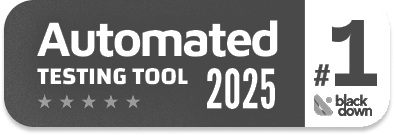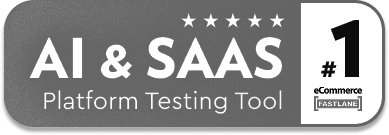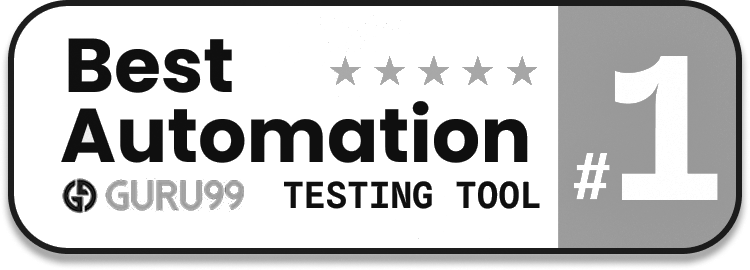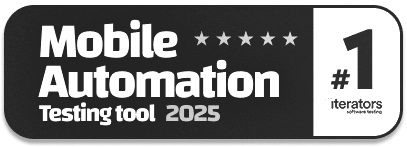AI and ML Tops 2025 Agenda for APAC CIOs
|
|
With the current technological advancements and the emergence of AI and ML, do you expect your organization’s overall IT budget to increase, decrease, or remain the same in 2025? According to the State of the CIO, 2025 (APAC) report by Foundry, technology budgets of 62% of organizations are expected to grow in APAC, up from 54% in 2024. This report offers in-depth perspectives on how the CIO role is transforming and highlights the key strategic initiatives shaping their agendas.
Let us review this report’s findings for CIOs, technology advancements, and their involvement in the tech paradigm.
Key Takeaways
- AI and ML are CIOs’ Priorities: AI and ML are at the forefront of APAC CIO agendas, with 79% planning their increased involvement in 2025. These technologies are viewed as catalysts for automation, innovation, and data-driven strategy.
- Increase in Technology Budgets: 62% of organizations in APAC expect their IT budgets to rise in 2025, reflecting growing tech demands. This increase supports strategic initiatives, from compliance to large-scale digital transformation.
- AI/ML Investment Areas are Expanding: CIOs are channeling funds into AI use cases like predictive analytics, generative AI, and NLP. These investments enable intelligent automation, faster decision-making, and tailored customer engagement.
- AI Agents are Central to Enterprise IT: AI agents are automating software testing, customer service, and operational workflows. Their autonomous nature helps organizations manage skill shortages and scale innovation.
- AI for Good Customer Experience: Nearly half of organizations are using AI to streamline customer support and service delivery. AI also helps personalize interactions, understand behavior, and adapt to changing demands.
- Talent Shortages are a Roadblock: Despite rising budgets, a shortage of skilled IT professionals hampers innovation efforts. CIOs must balance immediate operational challenges with long-term digital goals.
Reasons for Increasing Technology Budgets
First, let us review why the tech budgets will likely increase in 2025, as per APAC CIOs.
Additional Investments in AI/ML Projects
AI and machine learning are now central to many organizations’ digital strategies. Increased budgets support new use cases—from predictive analytics and intelligent automation to personalized customer experiences and fraud detection—requiring investment in platforms, data infrastructure, and specialized personnel.
Investment in New Skills
The shortage of advanced technical talent, especially in AI, cybersecurity, and data science, has prompted CIOs to dedicate more of their budget to hiring, training, and upskilling. Strategic partnerships with universities, certification programs, and internal learning initiatives are becoming more common.
Regulation Changes
Governments across the APAC region are introducing stricter data protection, cybersecurity, and digital compliance regulations. CIOs are allocating increased funds to ensure their organizations remain compliant. They are investing in tools for data governance, compliance management, and regulatory audits to avoid penalties and reputational damage. Read: Automated Testing Best Practices in Highly Regulated Industries.
To Scale IT Operations in Support of Business Growth
As businesses expand into new markets, launch new services, or experience digital growth, IT must scale accordingly. Budget increases are aimed at enhancing operational capacity, from service desks to DevOps teams, and expanding systems to support a larger user base.
Infrastructure Modernization/Migration
Legacy systems are being replaced or re-engineered to support agility and scalability. This includes migrating workloads to cloud platforms, upgrading network infrastructure, and adopting containerized environments. All of this requires substantial investment and technical planning.
Need for Security Improvements
With escalating cyber threats and more sophisticated attack surfaces, especially in hybrid environments, security has become a non-negotiable investment. Budgets are being channeled into zero-trust frameworks, endpoint protection, threat intelligence, and employee training to build organizational resilience.
Rising Costs of Technology and Services
Inflationary pressures and vendor pricing models have driven up the cost of software licenses, cloud subscriptions, cybersecurity tools, and managed services. Organizations are increasing IT budgets simply to maintain their existing technology stack, making cost optimization a parallel priority.
Investment in New Technologies
To future-proof their organizations, CIOs are exploring cutting-edge technologies like quantum computing, blockchain, generative AI, and edge computing. Early-stage experimentation and pilot programs are receiving more funding as companies aim to establish technical leadership in their industries. Read: Edge AI vs. Cloud AI.
Competitive Pressure
The speed of digital disruption in APAC markets has intensified. Organizations are boosting IT budgets to stay ahead or keep pace with nimble competitors. This includes investing in digital platforms, faster product iterations, and customer-centric technologies that offer a competitive edge.
Investing in Clean Information Technology
As environmental, social, and governance (ESG) criteria become central to corporate strategies, CIOs are under pressure to support sustainability through IT. Budgets are growing to fund initiatives such as energy-efficient data centers, e-waste reduction, carbon tracking systems, and investments in green cloud technologies. Read: Sustainability in Software Testing.
One-time Purchase or Major Project Planned for 2025
Many organizations are planning significant one-off expenditures, such as core system upgrades, enterprise software deployments, or large-scale digital transformation programs. These high-impact projects necessitate a temporary spike in technology spending, often requiring cross-functional coordination and external vendor partnerships.
Product Innovation
CIOs are allocating budget to technologies that enable rapid innovation, such as agile development platforms, prototyping tools, and cloud-native services. IT is playing a pivotal role in bringing new products to market for faster development cycles.
CIOs Expect an Increase in Their Involvement
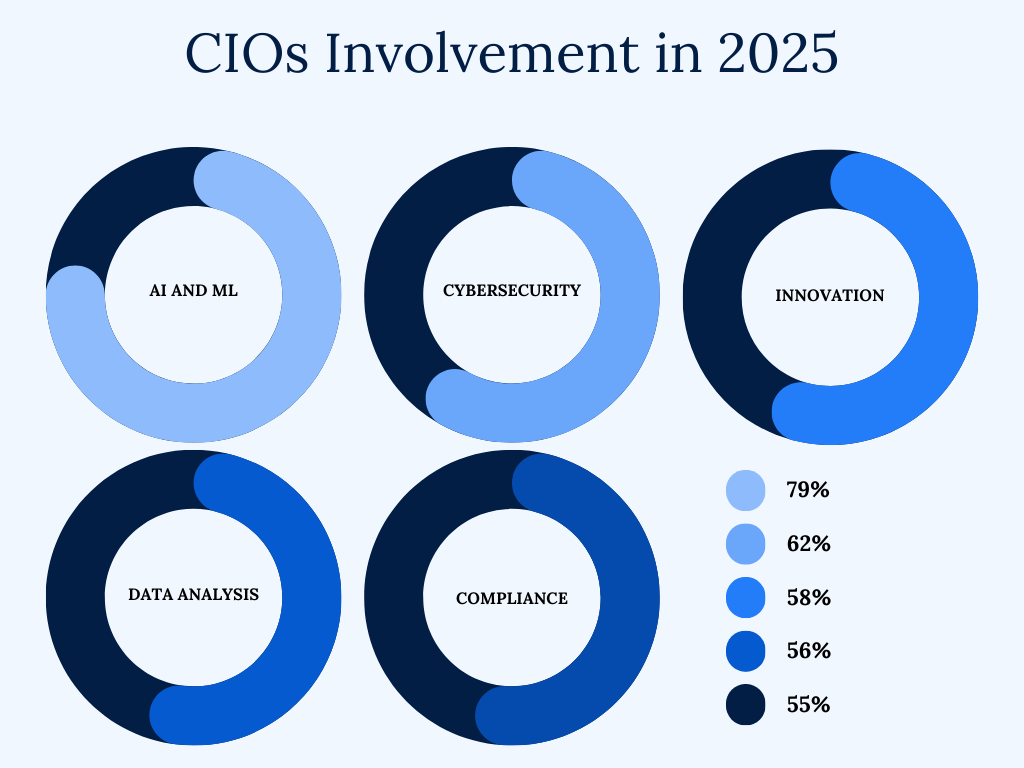
Here is the breakdown and details on how CIOs see their involvement in technology, with percentages.
AI and Machine Learning (79%)
Artificial Intelligence (AI) and Machine Learning (ML) have emerged as foundational technologies for innovation, automation, and data-driven decision-making. A significant majority of CIOs, i.e., 79%, anticipate increased involvement in this area. These are the key investment areas:
- Automation of Workflows: Enhancing operational efficiency through intelligent automation.
- Predictive Analytics: Using ML models to forecast trends, customer behavior, and risks.
- Personalization Engines: Powering tailored customer experiences in marketing and support.
- Natural Language Processing (NLP): Improving chatbots, virtual assistants, and knowledge management.
- Generative AI: Exploring creative applications in content, design, and software development.
Challenges Driving Demand:
- Growing data volumes require smarter processing
- Competitive pressure to innovate faster
- Talent shortages in AI are pushing investments in automation
Cybersecurity (62%)
With the rise of digital services and remote work, attack surfaces have expanded. As a result, 62% of CIOs plan to ramp up their involvement in cybersecurity in 2025. Data protection laws (e.g., GDPR, PDPA) and sector-specific compliance frameworks are driving more proactive security investments. These are the key investment areas:
- Zero Trust Architecture: Replacing perimeter-based security with identity-based controls.
- Threat Detection and Response Tools: Including SIEM, SOAR, and extended detection and response (XDR).
- Cloud and Endpoint Security: Protecting data in increasingly hybrid environments.
- Security Awareness Training: Building employee resilience against social engineering.
- Incident Response and Recovery Planning: Minimizing downtime and reputational risk.
Product Development/ Innovation (58%)
CIOs are no longer just IT operators. They are key drivers of business innovation. With 58% expecting their involvement, technology is becoming the backbone of product strategy. Innovation-led technology investments allow companies to differentiate in saturated markets and accelerate revenue generation from digital products. These are the key investment areas:
- Agile Development Platforms: Innovation regarding the DevOps pipelines.
- Rapid Prototyping Tools: Help in faster idea-to-market execution.
- Digital Experience Platforms: Vital to support user-centric products.
- Customer Feedback Loops and Experimentation: For example, A/B testing to know customer preferences and feedback.
- Collaborative Ecosystems: It will involve partners and startups to create an ecosystem of innovation.
Data Analysis (56%)
As organizations collect more data from digital channels, IoT, and customer interactions, the ability to interpret and act on this data becomes critical. 56% of CIOs see analytics as their priority. These are the key investment areas:
- Advanced Analytics and Business Intelligence (BI): These platforms provide better customer insights and personalization.
- Real-time Dashboards: They help as decision support tools and provide enhanced operational efficiency.
- Data Warehousing: Helps in a data-driven strategy across departments.
- Self-service Analytics Tools: For business users to make informed decisions.
- Predictive Modeling: This helps in better scenario planning.
Data Privacy/Compliance (55%)
With privacy breaches making headlines and laws becoming stricter, 55% of CIOs are prioritizing compliance. Otherwise, fines, reputational damage, cross-border data handling complexities, etc., may arise. These are the key investment areas:
- Data Governance Platforms: These are required for proper data classification and handling.
- Privacy Management Tools: Automating consent management and data subject rights.
- Audit and Reporting Tools: Supporting compliance with global frameworks (e.g., GDPR, CCPA).
- Access Control Systems: Ensuring only authorized access to sensitive data.
- Employee Training Programs: Building a privacy-first culture.
AI to Streamline Customer Experience
So when asked: In what ways, if any, is your organization using technology to improve customer experience? The APAC CIOs responded with these responses:
- Use AI/machine learning/automation to streamline/support customer service experience: 49%
- Analyze customer needs and behaviors: 44%
- Deliver products and services in new ways: 39%
- Adapt products and services to meet changing demands: 39%
- Improve the security of customer data: 38%
- Improve inefficiencies to reduce project timeline: 32%
- Have agents have the technology they need to respond rapidly/effectively to customers: 31%
- Provide alternatives to face-to-face communication: 27%
- Create new services based on a subscription model: 23%
These numbers clearly show that CIOs are focused on using AI, ML, and automation to enhance the customer experience. Read: Top 20 Metrics for CIO.
Role of AI Agents
As AI and ML dominate the 2025 agenda for APAC CIOs, with 79% expecting increased involvement, AI agents are seen as the critical enablers of enterprise innovation. Especially in areas like customer experience, automation, and software testing. These intelligent systems are designed to autonomously handle tasks such as predictive analytics, intelligent ticket routing, test execution, and workflow optimization. In a region where technology budgets are rising to meet challenges like regulatory compliance, market disruption, and digital innovation, AI agents help reduce the pressure of talent shortages by freeing up IT teams to focus on strategic initiatives. Read about AI agents in software testing.
One such AI agent, testRigor, lets you test graphs, images, chatbots, LLMs, Flutter apps, mainframes, and more. This is possible due to testRigor’s AI engine. Read more on this over here – AI Features Testing.
You can test across web, mobile (hybrid/native), desktop, APIs, databases, and mainframe apps using testRigor. Whether it is functional, visual, end-to-end, exploratory, or accessibility testing, this tool can take care of it for you. Read: How to use AI to test AI.
Gen AI is a capability that needs to be highlighted in testRigor, since the major roadblock in this CIO report is the lack of skilled people. With testRigor, you can create test cases in plain English. Use the generative AI feature to build test cases for you in minutes. Here’s more on how to do this: All-Inclusive Guide to Test Case Creation in testRigor.
Conclusion
The State of the CIO 2025 (APAC) report paints a clear picture: CIOs in the region are becoming pivotal agents of change, with AI and ML taking center stage in their strategic vision. As 62% of organizations plan to boost their IT budgets, driven by regulatory demands, sustainability goals, rising tech costs, and a surge in innovation, CIOs are stepping into their role as business enablers rather than just technology operators.
85% of CIOs report being more actively engaged in driving digital transformation initiatives than their business counterparts. However, this progress is not without its challenges. Despite growing budgets and ambitions, CIOs are contending with a persistent shortage of skilled talent, which threatens to stall initiatives in AI, cybersecurity, and product development. Here, AI agents are emerging as vital allies for automating routine tasks, enhancing efficiency, and supporting customer experience initiatives. Also, their ease of use bridges the gap between talent/skills and the task at hand.
| Achieve More Than 90% Test Automation | |
| Step by Step Walkthroughs and Help | |
| 14 Day Free Trial, Cancel Anytime |



